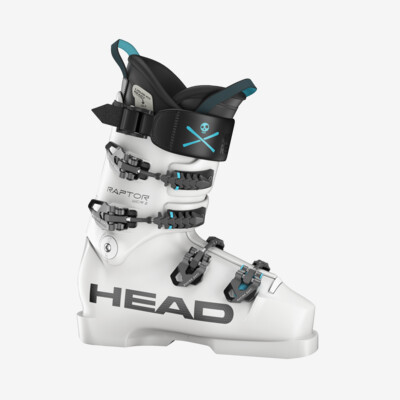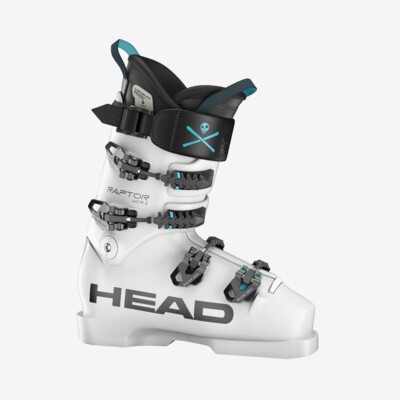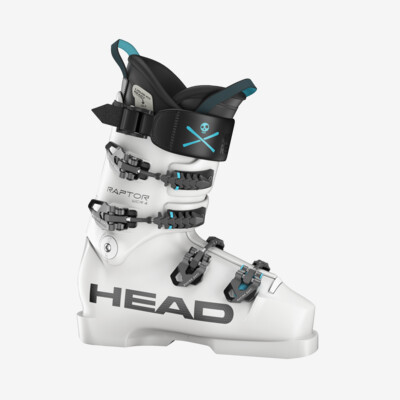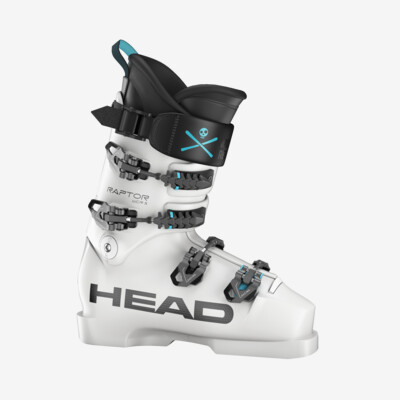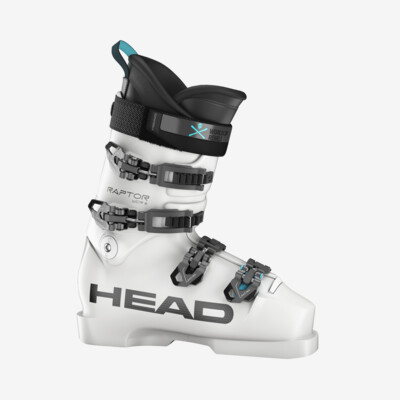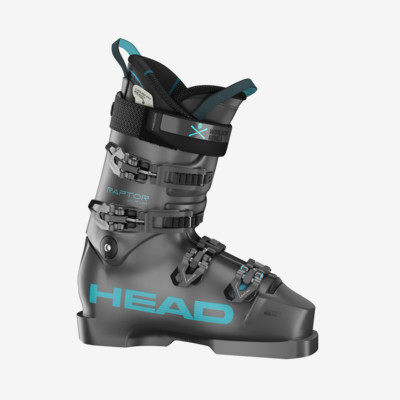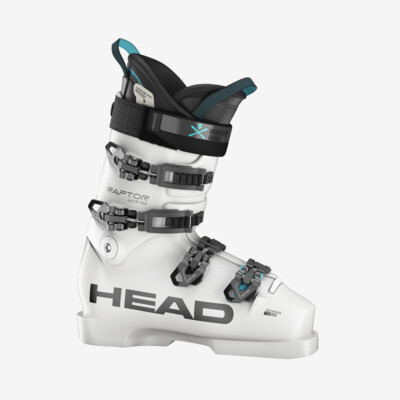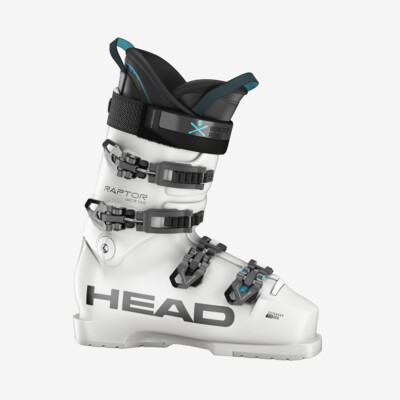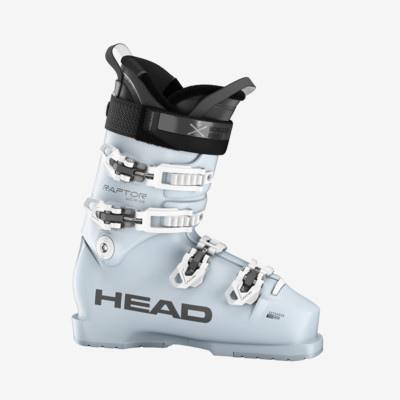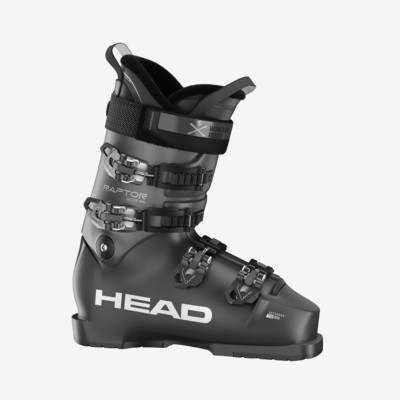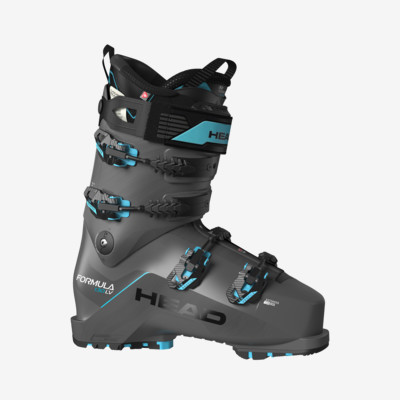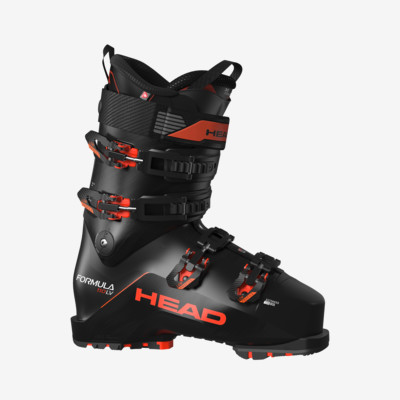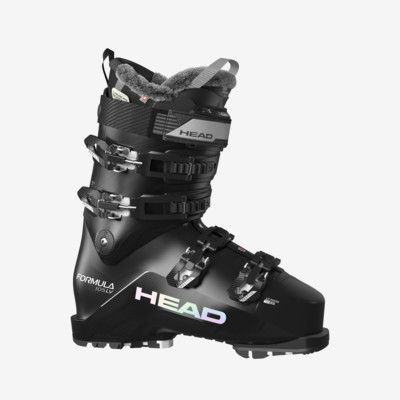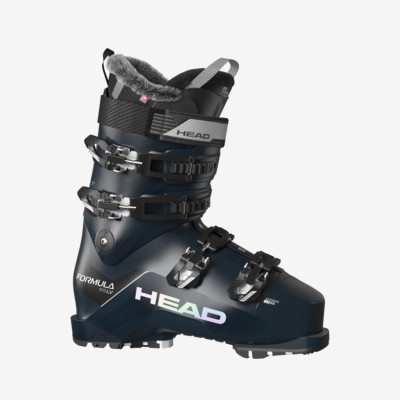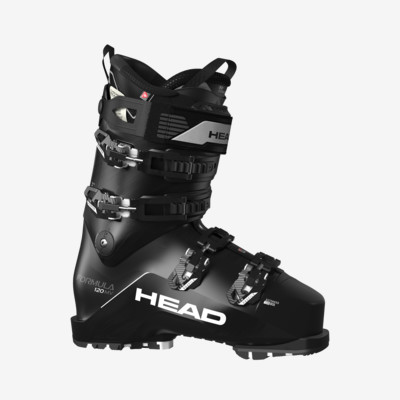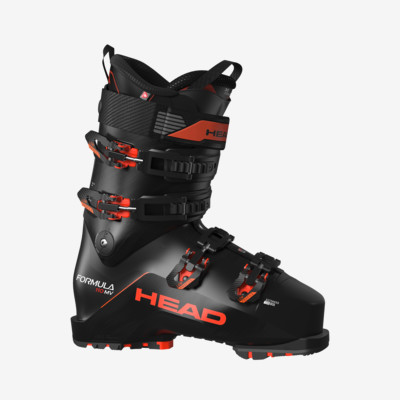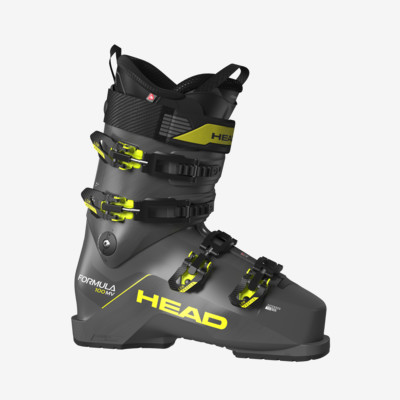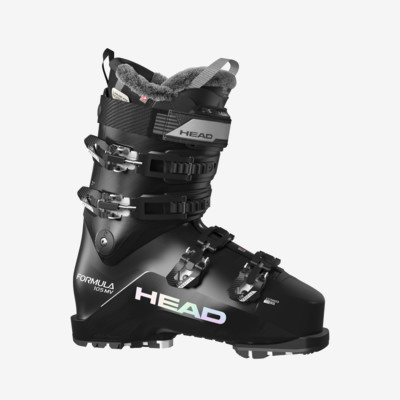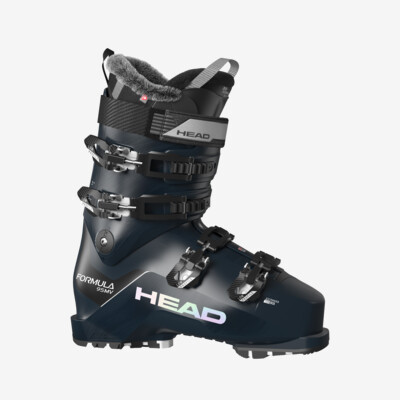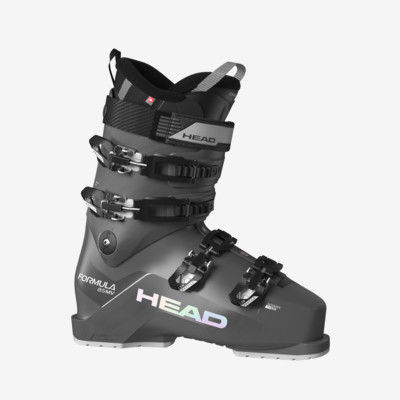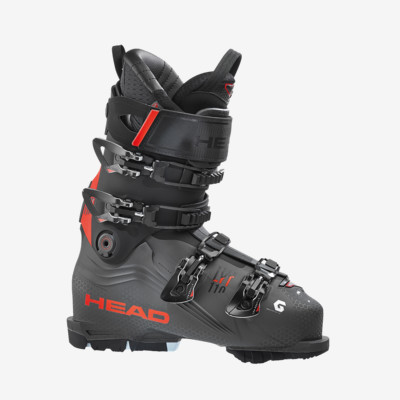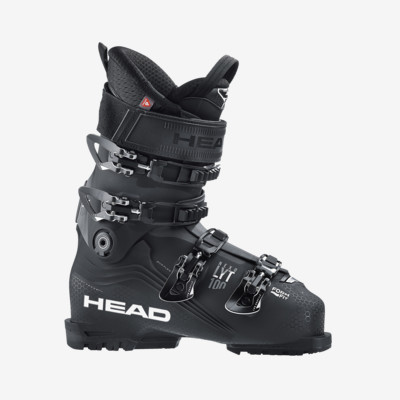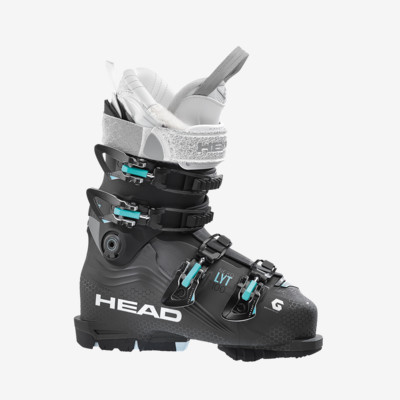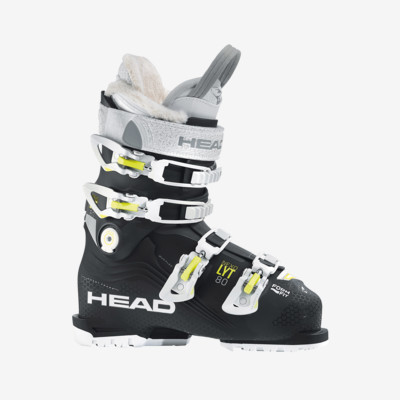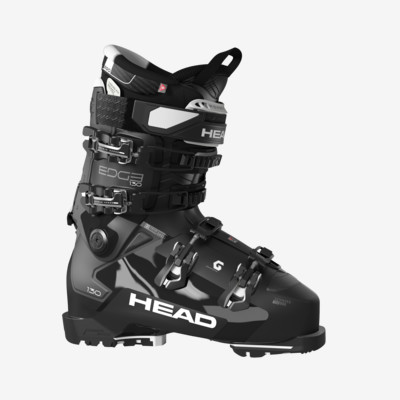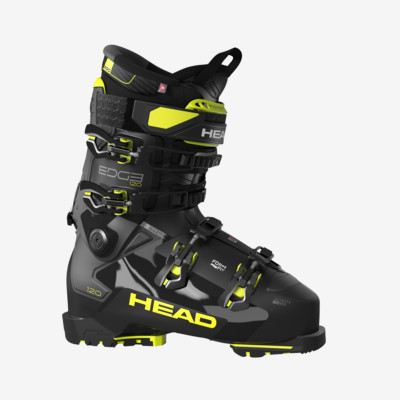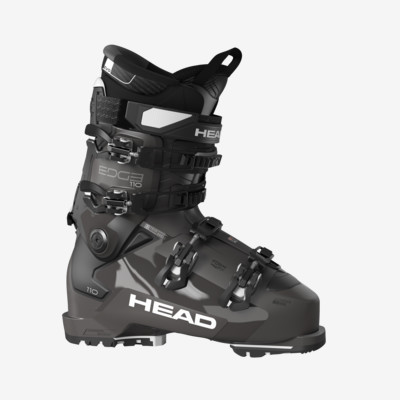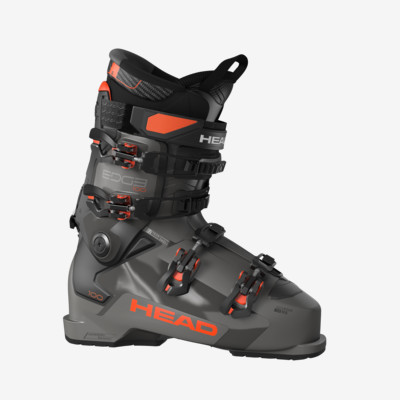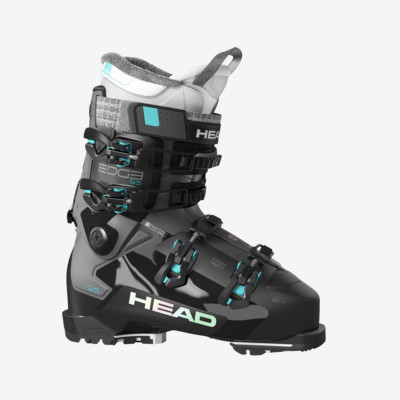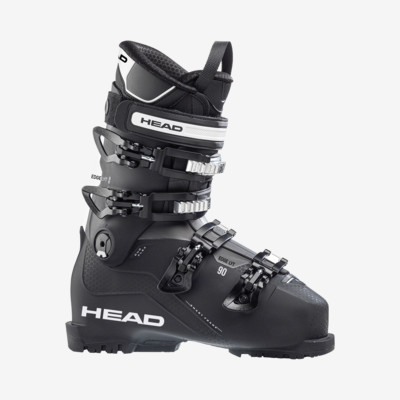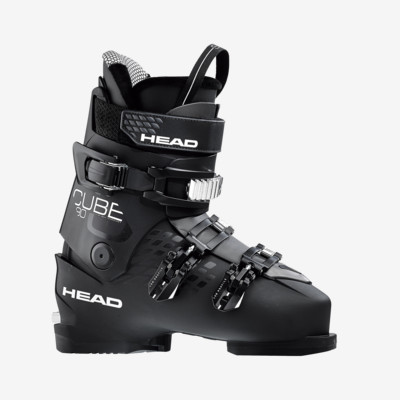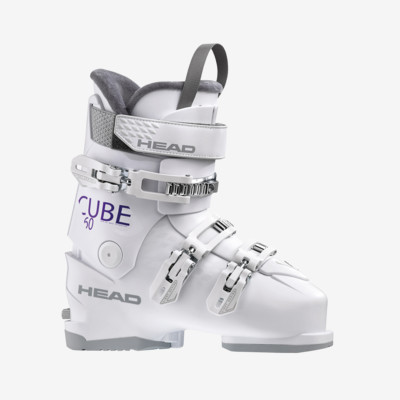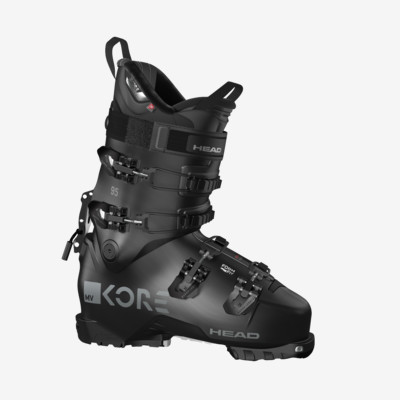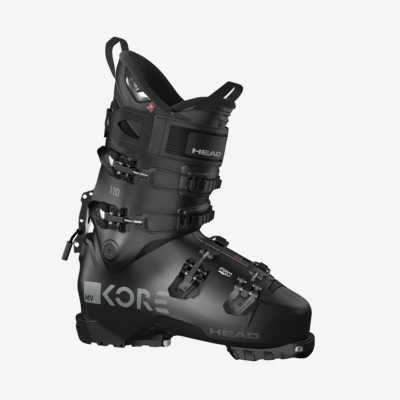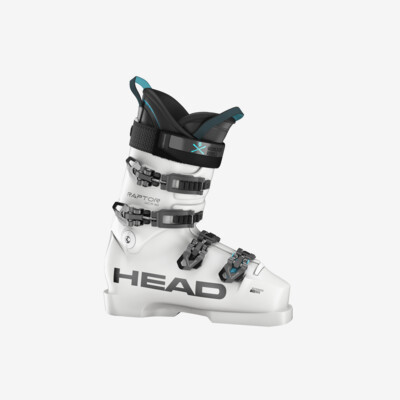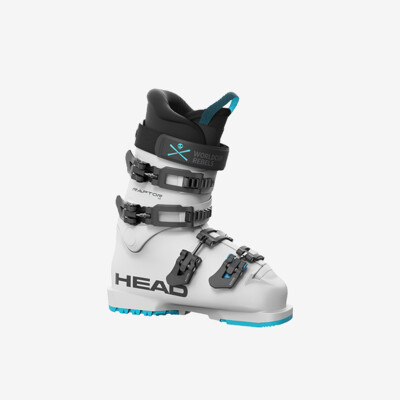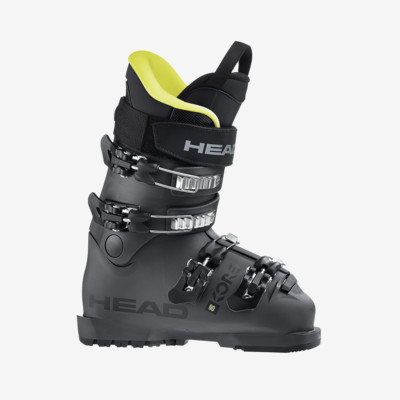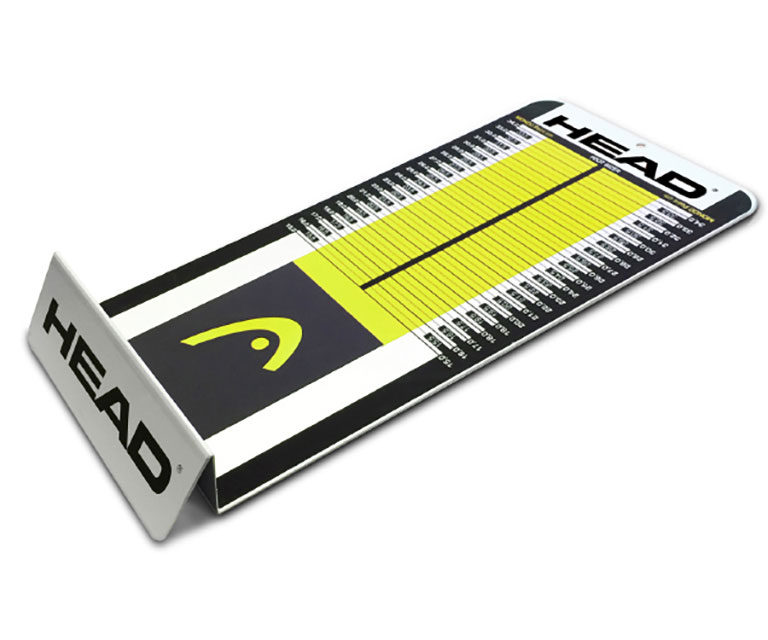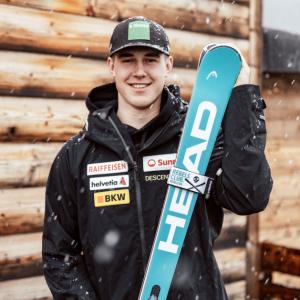
How to Choose the Right Ski Boots
Navigation:
> > Are ski boots specific to ability level?
> > What are the best types of ski boot for beginners?
> > What are the best types of ski boot for an intermediate skier?
> > What are the best types of ski boot for an advanced skier?
> > Do i need special boots to ski off piste?
> > How can ski boots be customized to fit my feet?
> > Should i size up or size down?
> > What does ‘last width’ mean?
> > How should the ski boots feel when they’re fitted correctly?
> > Do ski socks affect the fit of boots?
> > What flex of ski boot should i be looking for?
> > Do i need to check my boots are compatible with my bindings?
> > How can i adjust the canting of my ski boot?
Your choice of ski boots can make or break your day on the mountain. The right size, fit and flex will ensure you can happily ski for hours on end, whilst an uncomfortable pair will have you heading home early.
When choosing a ski boot, it’s essential to consider what type of skiing you are going to be doing and your ability level. Ski boots aren’t necessarily designed to suit specific skiing ability levels, but they do vary in flex and fit which make them better for certain disciplines and abilities. Everything works in tandem, so it’s important to ensure that your choice of boot works with your choice of ski and not against it.
Types of Ski Boot
Race
Race ski boots are designed for ski racers who need the maximum amount of control and power transfer on a race course. They will be at the stiffer end of the flex rating and have the snuggest fit, providing more-instant reactivity with the ski.
High Performance
Aimed at advanced to expert skiers, performance ski boots retain some of that stiffness that Race boots have, but with a greater focus on comfort. The aim of a performance boot is to offer a high level of control and reactivity with the ski, whilst providing the comfort to be able to ski all day.
Performance
Performance ski boots tend to be more lightweight and with a focus on comfort and ease-of-use. Their lightness allows you to maximise the time you can spend skiing around the mountain, accommodating last widths to cater for all foot shapes. These ski boots will feel great for ripping around the mountain, or simply just cruising back to the chalet after a long day on the slopes.
Women
There are many differences between male and female biomechanics, and ski boots are made to cater for these. An example is that women’s calves are a little lower on the leg, so the cuff of women’s ski boots is wider to accommodate that, as well as being shorter.
By choosing female specific ski boots as a woman, you’ll be maximising your chances of having a pain-free day charging around the slopes.
Freeride
When it comes to freeride ski boots, lightweight performance is the goal. Freeride boots still provide maximal control over the ski, but the lightweight nature helps provide comfort when hiking or skiing through deep snow. They also have backcountry specific features like a hiking mode and rockered soles, to make those ascents as comfortable and easy as the descents.
Junior
Junior ski boots are focused on a younger foot providing plenty of cushioning, but the range of boots within the HEAD Junior range cater for different disciplines from race to freestyle, varying with the difference in stiffness.
Are ski boots specific to ability level?
Whilst ski boots aren’t designed for specific ability levels, your choice of boot should match your ability level. As a beginner, you shouldn’t be looking at race boots where the stiffness won’t provide the comfort and forgiveness that you need.
As you gain more confidence and control of your skiing techniques, you will want to progress to a stiffer boot that allows you to transfer that control into your skis, so they react the way you want them to. The stiffer your ski boot, the faster those small movements in your feet will be transferred into your ski.
What are the best types of ski boot for beginners?
A beginner skier should look for a softer flexing boot, with an accommodating fit. This softness ensures that as a beginner you have a comfortable and enjoyable experience, which is essential when you are focusing on learning techniques. The softer flex is also more forgiving when mistakes do occur than a stiffer boot.
What are the best types of ski boot for an intermediate skier?
As an intermediate skier, look for medium flex boots with medium last width, to start building in that level of control and reactivity with the ski. You will be starting to ski faster and with more confidence and you want that confidence and control to be transferred into the ski through that increased stiffness.
What are the best types of ski boot for an advanced skier?
As an advanced skier, aim for ski boots with stiffer flex and a closer and more precise fit. Using fit technologies like HEAD’s Liquid Fit will ensure that the close fit is a comfortable one. The increased stiffness of the ski boot allows for more control and reactivity of the ski at speed, whilst the supportive sit ensures rapid response to your every movement.
With off-piste skiing being your primary focus on the mountain, then search for a freeride boot which is more lightweight and comfortable with medium to high flex. Particularly if you are wanting to get into ski-touring – a lightweight and comfortable boot is going to make your touring days a lot more enjoyable, particularly with all the walking uphill, and a ski hike mechanism will help you with this.
However, if like the majority of skiers, you are just dipping off the side of the piste from time to time and only gaining altitude by sitting on a chairlift, then a medium to stiff flexing boot will work great, providing the level of control that you need in deeper snow.
To find the perfect fit in a ski boot, HEAD advises you to focus on two important measurements: lenght and width.
Skiboot length
Ski boots are measured on a MONDOPOINT scale, which is based on the length in centimeters of your foot. The measurement is the exact length of a foot measured from heel to toe.
Ski Boots – Race – RAPTOR WCR
| EURO | US | UK | MONDO | Boot sole length |
| 34,5 | 3 - 3,5 | 2 - 2,5 | 22 | 264 |
| 35 - 35,5 | 3,5 - 4 | 2,5 - 3 | 22,5 | 264 |
| 36 | 4,5 | 3 - 3,5 | 23 | 274 |
| 36,5 - 37 | 5 | 4 | 23,5 | 274 |
| 37,5 | 5,5 | 4,5 | 24 | 284 |
| 38 - 38,5 | 6 | 5 | 24,5 | 284 |
| 39 | 6,5 - 7 | 5,5 - 6 | 25 | 294 |
| 39,5 - 40 | 7 - 7,5 | 6 - 6,5 | 25,5 | 294 |
| 40,5 | 8 | 6,5 - 7 | 26 | 304 |
| 41 - 41,5 | 8,5 | 7,5 | 26,5 | 304 |
| 42 | 9 | 8 | 27 | 314 |
| 42,5 - 43 | 9,5 - 10 | 8,5 - 9 | 27,5 | 314 |
| 43,5 | 10 - 10,5 | 9 - 9,5 | 28 | 325 |
| 44 - 44,5 | 11 | 9,5 - 10 | 28,5 | 325 |
Ski Boots – Race – RAPTOR Inline
| EURO | US | UK | MONDO | Boot sole length |
| 34,5 | 3 - 3,5 | 2 - 2,5 | 22 | 264 |
| 35 - 35,5 | 3,5 - 4 | 2,5 - 3 | 22,5 | 264 |
| 36 | 4,5 | 3 - 3,5 | 23 | 274 |
| 36,5 - 37 | 5 | 4 | 23,5 | 274 |
| 37,5 | 5,5 | 4,5 | 24 | 284 |
| 38 - 38,5 | 6 | 5 | 24,5 | 284 |
| 39 | 6,5 - 7 | 5,5 - 6 | 25 | 294 |
| 39,5 - 40 | 7 - 7,5 | 6 - 6,5 | 25,5 | 294 |
| 40,5 | 8 | 6,5 - 7 | 26 | 304 |
| 41 - 41,5 | 8,5 | 7,5 | 26,5 | 304 |
| 42 | 9 | 8 | 27 | 314 |
| 42,5 - 43 | 9,5 - 10 | 8,5 - 9 | 27,5 | 314 |
| 43,5 | 10 - 10,5 | 9 - 9,5 | 28 | 325 |
| 44 - 44,5 | 11 | 9,5 - 10 | 28,5 | 325 |
| 45 | 11,5 | 10,5 | 29 | 335 |
| 45,5 - 46 | 12 | 11 | 29,5 | 335 |
| 46,5 | 12,5 - 13 | 11,5 | 30 | 345 |
| 47 - 47,5 | 13 - 13,5 | 12 - 12,5 | 30,5 | 345 |
Ski Boots – High Performance – FORMULA
| EURO | US | UK | MONDO | Boot sole length |
| 36 | 4,5 | 3 - 3,5 | 23 | 273 |
| 36,5 - 37 | 5 | 4 | 23,5 | 273 |
| 37,5 | 5,5 | 4,5 | 24 | 283 |
| 38 - 38,5 | 6 | 5 | 24,5 | 283 |
| 39 | 6,5 - 7 | 5,5 - 6 | 25 | 293 |
| 39,5 - 40 | 7 - 7,5 | 6 - 6,5 | 25,5 | 293 |
| 40,5 | 8 | 6,5 - 7 | 26 | 303 |
| 41 - 41,5 | 8,5 | 7,5 | 26,5 | 303 |
| 42 | 9 | 8 | 27 | 313 |
| 42,5 - 43 | 9,5 - 10 | 8,5 - 9 | 27,5 | 313 |
| 43,5 | 10 - 10,5 | 9 - 9,5 | 28 | 323 |
| 44 - 44,5 | 11 | 9,5 - 10 | 28,5 | 323 |
| 45 | 11,5 | 10,5 | 29 | 333 |
| 45,5 - 46 | 12 | 11 | 29,5 | 333 |
| 46,5 | 12,5 - 13 | 11,5 | 30 | 343 |
| 47 - 47,5 | 13 - 13,5 | 12 - 12,5 | 30,5 | 343 |
Ski Boots – Performance – Nexo
| EURO | US | UK | MONDO | Boot sole length |
| 34,5 | 3 - 3,5 | 2 - 2,5 | 22 | 265 |
| 35 - 35,5 | 3,5 - 4 | 2,5 - 3 | 22,5 | 265 |
| 36 | 4,5 | 3 - 3,5 | 23 | 273 |
| 36,5 - 37 | 5 | 4 | 23,5 | 273 |
| 37,5 | 5,5 | 4,5 | 24 | 285 |
| 38 - 38,5 | 6 | 5 | 24,5 | 285 |
| 39 | 6,5 - 7 | 5,5 - 6 | 25 | 293 |
| 39,5 - 40 | 7 - 7,5 | 6 - 6,5 | 25,5 | 293 |
| 40,5 | 8 | 6,5 - 7 | 26 | 305 |
| 41 - 41,5 | 8,5 | 7,5 | 26,5 | 305 |
| 42 | 9 | 8 | 27 | 313 |
| 42,5 - 43 | 9,5 - 10 | 8,5 - 9 | 27,5 | 313 |
| 43,5 | 10 - 10,5 | 9 - 9,5 | 28 | 325 |
| 44 - 44,5 | 11 | 9,5 - 10 | 28,5 | 325 |
| 45 | 11,5 | 10,5 | 29 | 333 |
| 45,5 - 46 | 12 | 11 | 29,5 | 333 |
| 46,5 | 12,5 - 13 | 11,5 | 30 | 345 |
| 47 - 47,5 | 13 - 13,5 | 12 - 12,5 | 30,5 | 345 |
Ski Boots – Freeride – KORE
| EURO | US | UK | MONDO | Boot sole length |
| 36 | 4,5 | 3 - 3,5 | 23 | 273 |
| 36,5 - 37 | 5 | 4 | 23,5 | 273 |
| 37,5 | 5,5 | 4,5 | 24 | 285 |
| 38 - 38,5 | 6 | 5 | 24,5 | 285 |
| 39 | 6,5 - 7 | 5,5 - 6 | 25 | 293 |
| 39,5 - 40 | 7 - 7,5 | 6 - 6,5 | 25,5 | 293 |
| 40,5 | 8 | 6,5 - 7 | 26 | 305 |
| 41 - 41,5 | 8,5 | 7,5 | 26,5 | 305 |
| 42 | 9 | 8 | 27 | 313 |
| 42,5 - 43 | 9,5 - 10 | 8,5 - 9 | 27,5 | 313 |
| 43,5 | 10 - 10,5 | 9 - 9,5 | 28 | 325 |
| 44 - 44,5 | 11 | 9,5 - 10 | 28,5 | 325 |
| 45 | 11,5 | 10,5 | 29 | 333 |
| 45,5 - 46 | 12 | 11 | 29,5 | 333 |
| 46,5 | 12,5 - 13 | 11,5 | 30 | 343 |
| 47 - 47,5 | 13 - 13,5 | 12 - 12,5 | 30,5 | 343 |
Ski Boots – All Mountain – EDGE
| EURO | US | UK | MONDO | Boot sole length |
| 34,5 | 3 - 3,5 | 2 - 2,5 | 22 | 278 |
| 35 - 35,5 | 3,5 - 4 | 2,5 - 3 | 22,5 | 278 |
| 36 | 4,5 | 3 - 3,5 | 23 | 278 |
| 36,5 - 37 | 5 | 4 | 23,5 | 278 |
| 37,5 | 5,5 | 4,5 | 24 | 290 |
| 38 - 38,5 | 6 | 5 | 24,5 | 290 |
| 39 | 6,5 - 7 | 5,5 - 6 | 25 | 298 |
| 39,5 - 40 | 7 - 7,5 | 6 - 6,5 | 25,5 | 298 |
| 40,5 | 8 | 6,5 - 7 | 26 | 310 |
| 41 - 41,5 | 8,5 | 7,5 | 26,5 | 310 |
| 42 | 9 | 8 | 27 | 318 |
| 42,5 - 43 | 9,5 - 10 | 8,5 - 9 | 27,5 | 318 |
| 43,5 | 10 - 10,5 | 9 - 9,5 | 28 | 330 |
| 44 - 44,5 | 11 | 9,5 - 10 | 28,5 | 330 |
| 45 | 11,5 | 10,5 | 29 | 337 |
| 45,5 - 46 | 12 | 11 | 29,5 | 337 |
| 46,5 | 12,5 - 13 | 11,5 | 30 | 349 |
| 47 - 47,5 | 13 - 13,5 | 12 - 12,5 | 30,5 | 349 |
| 48 | 14 | 12,5 - 13 | 31 | 369 |
| 48,5 - 49 | 14,5 | 13 - 13,5 | 31,5 | 369 |
| 49,5 | 15 | 14 | 32 | 369 |
| 50 - 50,5 | 15,5 - 16 | 14,5 | 32,5 | 369 |
| 51 | 16 - 16,5 | 15 - 15,5 | 33 | 386 |
| 51,5 - 52 | 17 | 15,5 - 16 | 33,5 | 386 |
| 52,5 | 17,5 | 16 - 16,5 | 34 | 386 |
| 53 - 53,5 | 18 | 17 | 34,5 | 386 |
Ski Boots – All Mountain – ADVANTEDGE
| EURO | US | UK | MONDO | Boot sole length |
| 36 | 4,5 | 3 - 3,5 | 23 | 273 |
| 36,5 - 37 | 5 | 4 | 23,5 | 273 |
| 37,5 | 5,5 | 4,5 | 24 | 285 |
| 38 - 38,5 | 6 | 5 | 24,5 | 285 |
| 39 | 6,5 - 7 | 5,5 - 6 | 25 | 293 |
| 39,5 - 40 | 7 - 7,5 | 6 - 6,5 | 25,5 | 293 |
| 40,5 | 8 | 6,5 - 7 | 26 | 305 |
| 41 - 41,5 | 8,5 | 7,5 | 26,5 | 305 |
| 42 | 9 | 8 | 27 | 313 |
| 42,5 - 43 | 9,5 - 10 | 8,5 - 9 | 27,5 | 313 |
| 43,5 | 10 - 10,5 | 9 - 9,5 | 28 | 325 |
| 44 - 44,5 | 11 | 9,5 - 10 | 28,5 | 325 |
| 45 | 11,5 | 10,5 | 29 | 333 |
| 45,5 - 46 | 12 | 11 | 29,5 | 333 |
| 46,5 | 12,5 - 13 | 11,5 | 30 | 345 |
| 47 - 47,5 | 13 - 13,5 | 12 - 12,5 | 30,5 | 345 |
| 48 | 14 | 12,5 - 13 | 31 | 361 |
| 48,5 - 49 | 14,5 | 13 - 13,5 | 31,5 | 361 |
| 49,5 | 15 | 14 | 32 | 361 |
| 50 - 50,5 | 15,5 - 16 | 14,5 | 32,5 | 361 |
| 51 | 16 - 16,5 | 15 - 15,5 | 33 | 381 |
| 51,5 - 52 | 17 | 15,5 - 16 | 33,5 | 381 |
| 52,5 | 17,5 | 16 - 16,5 | 34 | 381 |
| 53 - 53,5 | 18 | 17 | 34,5 | 381 |
Ski Boots – All Mountain – CUBE
| EURO | US | UK | MONDO | Boot sole length |
| 36 | 4,5 | 3 - 3,5 | 23 | 281 |
| 36,5 - 37 | 5 | 4 | 23,5 | 281 |
| 37,5 | 5,5 | 4,5 | 24 | 293 |
| 38 - 38,5 | 6 | 5 | 24,5 | 293 |
| 39 | 6,5 - 7 | 5,5 - 6 | 25 | 301 |
| 39,5 - 40 | 7 - 7,5 | 6 - 6,5 | 25,5 | 301 |
| 40,5 | 8 | 6,5 - 7 | 26 | 313 |
| 41 - 41,5 | 8,5 | 7,5 | 26,5 | 313 |
| 42 | 9 | 8 | 27 | 321 |
| 42,5 - 43 | 9,5 - 10 | 8,5 - 9 | 27,5 | 321 |
| 43,5 | 10 - 10,5 | 9 - 9,5 | 28 | 333 |
| 44 - 44,5 | 11 | 9,5 - 10 | 28,5 | 333 |
| 45 | 11,5 | 10,5 | 29 | 341 |
| 45,5 - 46 | 12 | 11 | 29,5 | 341 |
| 46,5 | 12,5 - 13 | 11,5 | 30 | 353 |
| 47 - 47,5 | 13 - 13,5 | 12 - 12,5 | 30,5 | 353 |
| 48 | 14 | 12,5 - 13 | 31 | 369 |
| 48,5 - 49 | 14,5 | 13 - 13,5 | 31,5 | 369 |
| 49,5 | 15 | 14 | 32 | 369 |
Ski Boots – Junior – RAPTOR WCR
| EURO | US | UK | MONDO | Boot sole length |
| 34,5 | 3 - 3,5 | 2 - 2,5 | 22 | 264 |
| 35 - 35,5 | 3,5 - 4 | 2,5 - 3 | 22,5 | 264 |
| 36 | 4,5 | 3 - 3,5 | 23 | 274 |
| 36,5 - 37 | 5 | 4 | 23,5 | 274 |
| 37,5 | 5,5 | 4,5 | 24 | 284 |
| 38 - 38,5 | 6 | 5 | 24,5 | 284 |
| 39 | 6,5 - 7 | 5,5 - 6 | 25 | 294 |
| 39,5 - 40 | 7 - 7,5 | 6 - 6,5 | 25,5 | 294 |
| 40,5 | 8 | 6,5 - 7 | 26 | 304 |
| 41 - 41,5 | 8,5 | 7,5 | 26,5 | 304 |
| 42 | 9 | 8 | 27 | 314 |
| 42,5 - 43 | 9,5 - 10 | 8,5 - 9 | 27,5 | 314 |
| 43,5 | 10 - 10,5 | 9 - 9,5 | 28 | 325 |
| 44 - 44,5 | 11 | 9,5 - 10 | 28,5 | 325 |
Ski Boots – Junior – RAPTOR / KORE
| EURO | US | UK | MONDO | Boot sole length |
| 27 | 10,5 | 9 - 9,5 | 17 | 225 |
| 27,5 - 28 | 11 | 9,5 - 10 | 17,5 | 225 |
| 28,5 | 11,5 | 10,5 | 18 | 225 |
| 29 - 29,5 | 12 | 11 | 18,5 | 225 |
| 30 | 12,5 - 13 | 11,5 | 19 | 237 |
| 30,5 - 31 | 13 - 13,5 | 12 - 12,5 | 19,5 | 237 |
| 31,5 | 1 | 12,5 - 13 | 20 | 245 |
| 32 - 32,5 | 1,5 | 13 - 13,5 | 20,5 | 245 |
| 33 | 2 | 1 | 21 | 257 |
| 33,5 - 34 | 2,5 | 1,5 | 21,5 | 257 |
| 34,5 | 3 - 3,5 | 2 - 2,5 | 22 | 265 |
| 35 - 35,5 | 3,5 - 4 | 2,5 - 3 | 22,5 | 265 |
| 36 | 4,5 | 3 - 3,5 | 23 | 277 |
| 36,5 - 37 | 5 | 4 | 23,5 | 277 |
| 37,5 | 5,5 | 4,5 | 24 | 285 |
| 38 - 38,5 | 6 | 5 | 24,5 | 285 |
| 39 | 6,5 - 7 | 5,5 - 6 | 25 | 297 |
| 39,5 - 40 | 7 - 7,5 | 6 - 6,5 | 25,5 | 297 |
| 40,5 | 8 | 6,5 - 7 | 26 | 305 |
| 41 - 41,5 | 8,5 | 7,5 | 26,5 | 305 |
| 42 | 9 | 8 | 27 | 317 |
| 42,5 - 43 | 9,5 - 10 | 8,5 - 9 | 27,5 | 317 |
Ski Boots – Junior – Z1 / Z2 / Z3
| EURO | US | UK | MONDO | Boot sole length |
| 24 | 8 | 7 | 15 | 205 |
| 24,5 - 25 | 8,5 | 7,5 | 15,5 | 205 |
| 25,5 | 9 | 8 | 16 | 205 |
| 26 - 26,5 | 9,5 - 10 | 8,5 - 9 | 16,5 | 205 |
| 27 | 10,5 | 9 - 9,5 | 17 | 225 |
| 27,5 - 28 | 11 | 9,5 - 10 | 17,5 | 225 |
| 28,5 | 11,5 | 10,5 | 18 | 225 |
| 29 - 29,5 | 12 | 11 | 18,5 | 225 |
| 30 | 12,5 - 13 | 11,5 | 19 | 237 |
| 30,5 - 31 | 13 - 13,5 | 12 - 12,5 | 19,5 | 237 |
| 31,5 | 1 | 12,5 - 13 | 20 | 245 |
| 32 - 32,5 | 1,5 | 13 - 13,5 | 20,5 | 245 |
| 33 | 2 | 1 | 21 | 257 |
| 33,5 - 34 | 2,5 | 1,5 | 21,5 | 257 |
| 34,5 | 3 - 3,5 | 2 - 2,5 | 22 | 265 |
| 35 - 35,5 | 3,5 - 4 | 2,5 - 3 | 22,5 | 265 |
| 36 | 4,5 | 3 - 3,5 | 23 | 277 |
| 36,5 - 37 | 5 | 4 | 23,5 | 277 |
| 37,5 | 5,5 | 4,5 | 24 | 285 |
| 38 - 38,5 | 6 | 5 | 24,5 | 285 |
| 39 | 6,5 - 7 | 5,5 - 6 | 25 | 297 |
| 39,5 - 40 | 7 - 7,5 | 6 - 6,5 | 25,5 | 297 |
| 40,5 | 8 | 6,5 - 7 | 26 | 305 |
| 41 - 41,5 | 8,5 | 7,5 | 26,5 | 305 |
You can measure yourself at home but we recommend you get your ski boots fitted by a professional, who can measure your foot with an official sizing device. Not only will you have the chance to try them out and ensure they’re comfortable before you buy them, but the boot fitter will be able to help guide you towards the right boot for your ability and skiing style.
How are ski boots fitted?
When you visit a boot-fitter, they will find out what sort of skiing you like to do, what your level is and how often you will be skiing during the season.
Next, they should take a look at your feet so they can get an idea for the best last width that matches your feet. They will then select a few ski boots for you that will be best suited to your skiing and your feet profile, and you can see which is the most comfortable one. Once you’ve chosen the boot for you, the customization process truly begins - partly for better comfort but also for increased control as the boot will be aligned to your foot perfectly.
There are a variety of HEAD boot technologies that ensure that your ski boot is as customized to your foot as possible. HEAD Liquid Fit creates the most precise mold in the most critical area of the boot – namely the ankle and the heel pocket, providing flexibility, comfort and performance.
The brilliance of HEAD liners is that they’re fully mouldable to you, providing you with the comfort to ski all day, and the control to transfer those intricate movements of your feet onto your ski.
Custom insoles are usually recommended to ensure the arches of your feet are supported, and these are considered when getting your boots fitted. There are other options like adding wedges to minimise heel lift, blowing the shell out or thinning the shell to create a custom fit for you and to ensure maximum performance and comfort.
Should I size up or size down?
Neither – you should size correctly! Different brands between ski boots and normal trainers won’t size the same, so whichever boot fits the best and is most comfortable should be the one you go for. A visit to a boot-fitter will give you the best chance of finding a ski boot that fits perfectly.
What does ‘last width’ mean?
Last width is a traditional term when it comes to ski boot and shoe fitting, and it’s to do with the width of the foot and the width of the boot in a size 26.5. Traditionally, higher performance boots will have the thinnest last width to offer the closest fit and instant responsiveness. Last widths generally range from 93mm to 104mm. A 1mm difference in width can make all the difference to your boot fit.
How should the ski boots feel when they’re fitted correctly?
First, step into your boot and while standing wiggle your toes. You should have minimal space between the end of your toes and the end of your boot. Your toes should be brushing the end of the boot and shouldn’t feel squashed, but similarly there shouldn’t feel like there is plenty of empty space there.
Next, bend your knees, flexing forwards into your boot. If the boots are fitted correctly you should feel your toes free up and you should be able to wiggle them, whilst your heel should feel planted and secure. If it does lift – there are various technologies that can help, from HEAD Liquid Fit to a simple heel wedge.
Do ski socks affect the fit of boots?
Ski socks have a huge influence on the performance and fit of a ski boot. Extra thick socks generally limit blood circulation and provide less warmth by trapping moisture around the foot. A thinner sock will offer greater sensitivity and precision whilst managing moisture better and keeping the foot dry.
Some people go for a happy medium between a thin and thick sock, to add a little more cushioning without sacrificing too much performance. Whatever sock you choose, they should fit well with no ripples or bobbles, and they should preferably be made of a wicking material, usually a synthetic and wool blend.
When you go to a boot-fitter to try on boots and have them moulded, you need to wear the style of socks that you will be skiing in, as this will maximise the comfortability and fit of the boot.
What flex of ski boot should I be looking for?
Choosing the right flex is relevant to your ability level and the type of skiing you are going to be doing. As we have mentioned above, a stiffer flex will be geared towards someone who is an advanced skier or is looking to get into ski racing, whilst a mid-flex is aimed more at intermediate and all mountain skiers.
Your weight and strength may come into choosing a boot with the right flex, with someone who is slightly heavier opting for a stiffer boot.
These are all great things to consider and talk to your boot-fitter about, to help them find the best ski boot for you.
Do I need to check my boots are compatible with my bindings?
This is a definite ‘yes’, as certain boots won’t fit well with all bindings, so try align your ski set-up so your bindings match your boots nicely. The last thing you want is for bindings that don’t match your pair of boots, as you’ll be at risk of accidental pre-releases which can cause crashes and injuries, or your boot not releasing from the binding properly when you fall.
What is canting?
The canting of a ski boot can be explained as the lateral alignment of the upper cuff, enabling the skier to tune the boot geometry to your own bio-mechanics. The main purpose of the canting set up is to find a natural stance on your skis, allowing for a gradual and more efficient entry and exit of a carve. HEAD ski boots have an initial canting set up, which is related to the performance of a ski boot.
How can I adjust the canting of my ski boot?
On most Performance and Race boots, it’s easy to tune the canting. You will find adjustment points at the ankle pivot, with the degree of adjustment varying from boot to boot.














